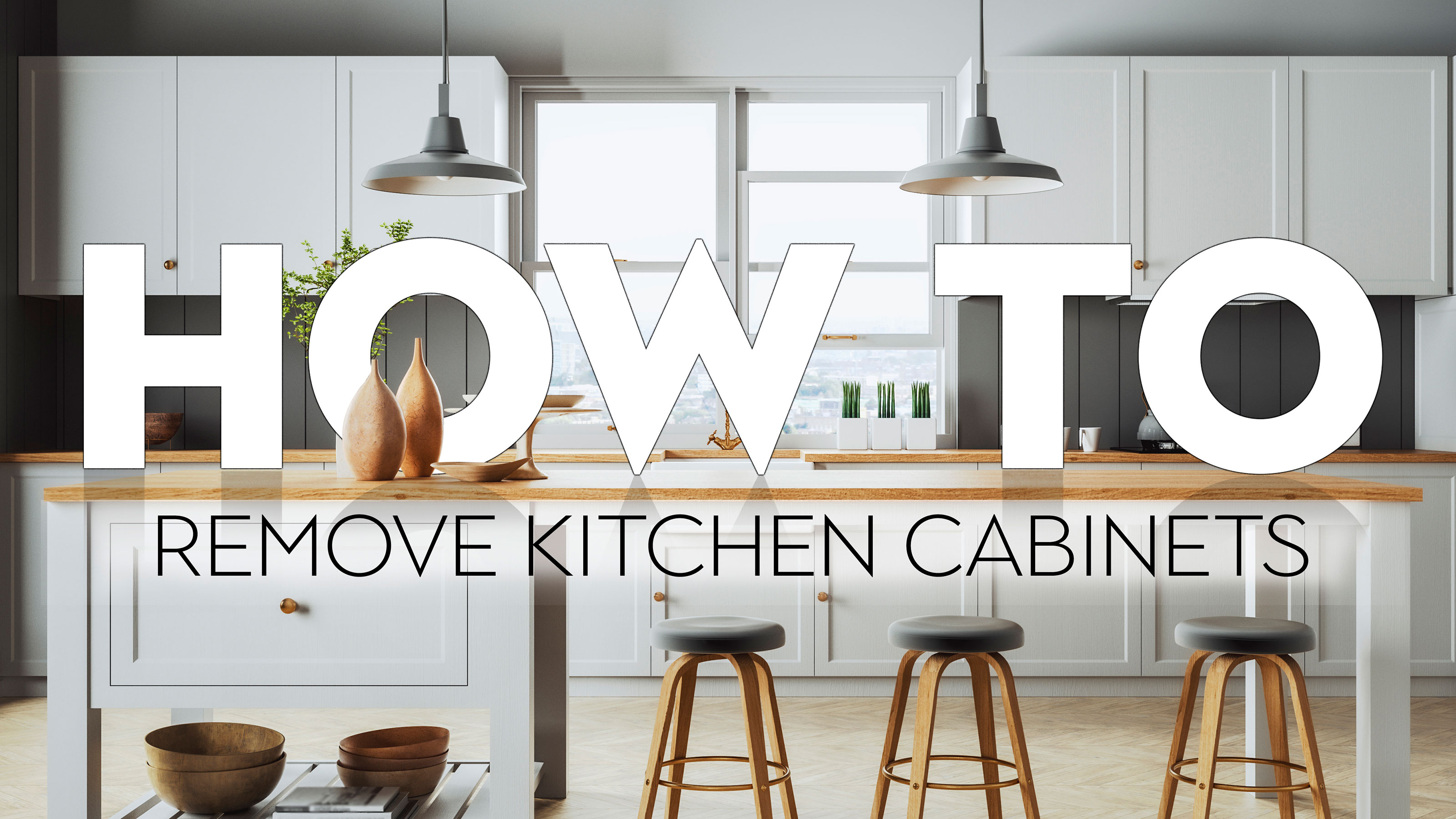How to remove kitchen cabinets DIY – without damaging them
When you know how to remove kitchen cabinets properly – without damaging them – it can give them and your kitchen a new lease of life. Keep them in top condition to paint and reuse them. You could even sell them on for a little extra cash...


Knowing how to remove kitchen cabinets without damaging them can save – or even make you – money. While they might no longer be the cabinets you want in your kitchen, if they are in good condition, they could be perfect for someone else’s home. Or you might want to re-use them yourself for a mudroom, or to create better storage in the garage.
Whether to make room for a full kitchen remodel or not, if your cabinets are going to enjoy a second life, it’s imperative to take them out properly so as not to cause them any damage. That’s where we come in.
Our guide has all you need to know about removing kitchen cabinets, along with pro tips and tricks to help you get the job done.
How to remove kitchen cabinets: step by step
Much like when you're installing new kitchen cabinets, removing them needs to be done with care. Take yours off properly and they can be reused by you or even sold. Going to take the latter option? ‘Take a photo of the kitchen before you take it apart and advertise the kitchen cabinets for sale,’ recommends Jacob Naig, owner of We Buy Houses In Des Moines. ‘Everybody wants these for a kitchen or garage work space. It almost doesn’t matter the condition, just price accordingly.’
After all, the better state that they come down in, the better chance a buyer has to realize their dream kitchen cabinet ideas so it's worth sweetening the deal from stage one.
You will need:
- Safety goggles
- Gloves
- Dust mask
- Wrench
- Screwdriver
- Utility knife
- Putty knives
- Crowbar or pry bar
1. Prepare the kitchen
Before you can remove kitchen cabinets, you will need to clear them of their contents, which should be stored safely away from the area. Don’t forget anything you might have stashed on top of them, or anything attached to them, such as paper towel holders.
Get small space home decor ideas, celeb inspiration, DIY tips and more, straight to your inbox!
If interior shelves are removable, take these out.
Turn off the water supply to the sink at the shut-off valve below. Turn off the electricity to the room at the breaker box, too.
Remove appliances, bearing in mind you may need to call in qualified pros to ensure these are disconnected safely.
2. Remove the sink
Take out the kitchen sink. Disconnect the water supply lines from the faucet, and disconnect the sink drain pipe. Any garbage disposal will also need to be disconnected and removed.
Cut through the caulking around the sink using a utility knife then unscrew the sink from the countertop, and lift out. Stainless steel won’t be weighty, but work with someone else if the sink is made from heavy porcelain.
3. Remove the countertop
Countertops are generally fitted from underneath, and the screws will need to be undone, including at the joins. ‘If they are laminate, they are secured by a few screws and a caulk line on the wall,’ explains Jacob Naig. ‘Take out the screws and cut the caulk line with a knife.’
A countertop will lift off, but make sure you work with someone else and lift it out carefully.
4. Remove cabinet trim and molding
Remove the molding and trim of the cabinets next. This can crack, so to avoid damage, try this method from experienced general contractor and installer Edward Jones of HomeCareHow.
‘Use a putty knife together with your crowbar or pry bar,’ Edward advises. ‘Find a nail, and slide a putty knife between your cabinet and trim. Slowly pull the putty knife before inserting your pry bar. If the trim is about crack, you can use your second putty knife. You can repeat the whole process until you've removed every nail.’
5. Remove doors and drawers
Cabinet doors as well as any drawers should be removed. You might find there are release clips that allow the doors to be taken off, but otherwise you will need to unscrew the hinges. Get a buddy to support the weight of the door as you unscrew it.
Make sure you don’t lose small parts as you work. ‘Keep loose screws and hinges from each cabinet in plastic bags or containers so that nothing gets misplaced,’ says Andre Kazimierski, CEO, Improovy Painters Chicago.
Drawers can be lifted out but watch out for clips that need to be undone first.
6. Remove base cabinets
While you can work in any order to remove kitchen cabinets, you can make the task easier by removing the base cabinets first. ‘That way when you remove the upper cabinets, you can stand under the cabinet without leaning over the base cabinet,’ explains Jacob Naig.
Working one cabinet at a time, unscrew them at the back as well as removing screws between cabinets, if they are screwed together. Pull out gently.
‘I never use a hammer to beat them apart,’ says Jacob. ‘Using a hammer like you see on TV to remove them makes the job harder.’
7. Remove wall cabinets
It is important to be aware of safety when removing wall cabinets. ‘The essential step is making sure you have muscle in place to catch the cabinet when the last fastener holding it to the wall is removed,’ says Leonard Ang, CEO of iPropertyManagement. ‘I recommend working in a team of two to three people if possible.’
Begin by taking out the screws between the wall cabinets, then working one cabinet at a time, unscrew from the wall, starting at the bottom. ‘When you remove the last two screws, make sure you have helpers ready to catch the cabinet,’ says Leonard.
Lift the cabinet carefully off the wall. Repeat with the remaining cabinets.
How do you remove kitchen cabinets for reuse?
By following the above steps and not damaging the individual units, you'll be able to remove yours from the wall and upgrade them how you'd like before re-installing and therefore, re-using them in your kitchen. A couple of options you have are to paint kitchen cabinets, or you could finish them in a different stain. It depends on the kitchen cabinet material and style you're working with, as well as your budget and willingness to DIY, of course!
How do you remove kitchen cabinets that are glued?
If you’re removing kitchen cabinets from the wall and they don’t come loose after you’ve removed the last screw, you could find that they were glued in place as well as screwed when they were installed.
‘If this is the case, you may need crowbars or other tools to remove them from the wall, and will definitely want people on hand to help catch them when they finally come loose,’ says Leonard Ang.

Sarah is a freelance journalist and editor writing for websites, national newspapers, and magazines. She’s spent most of her journalistic career specialising in homes – long enough to see fridges become smart, decorating fashions embrace both minimalism and maximalism, and interiors that blur the indoor/outdoor link become a must-have. She loves testing the latest home appliances, revealing the trends in furnishings and fittings for every room, and investigating the benefits, costs and practicalities of home improvement. It's no big surprise that she likes to put what she writes about into practice, and is a serial house revamper. For Realhomes.com, Sarah reviews coffee machines and vacuum cleaners, taking them through their paces at home to give us an honest, real life review and comparison of every model.